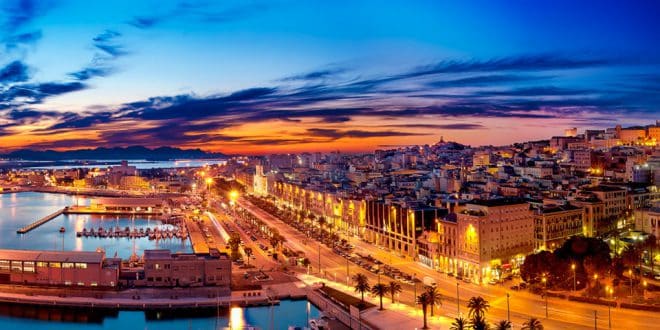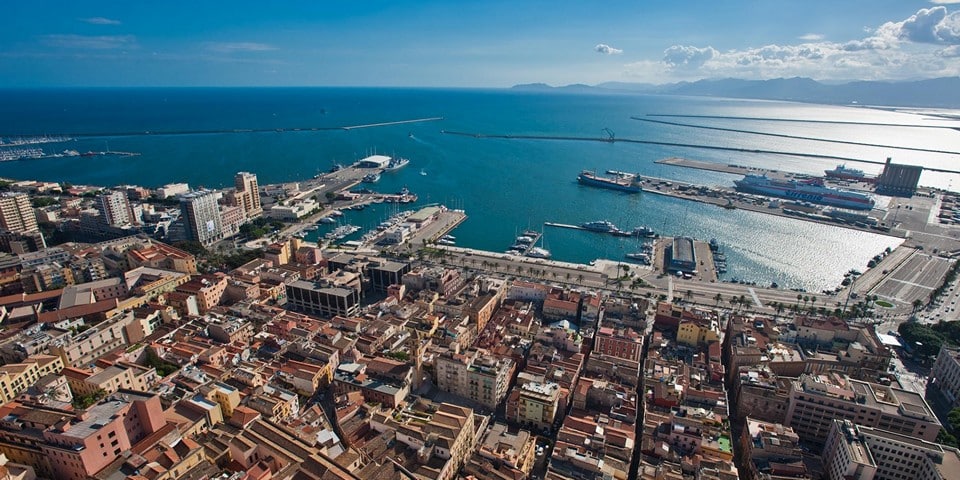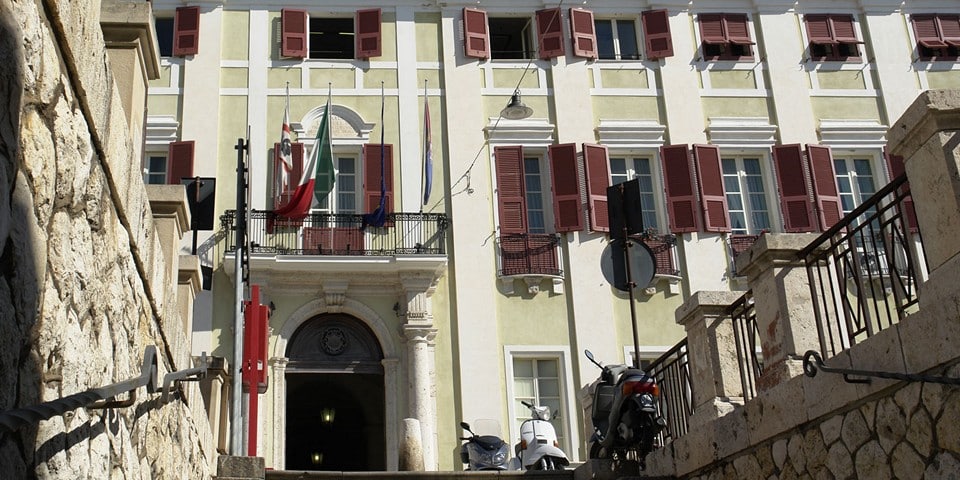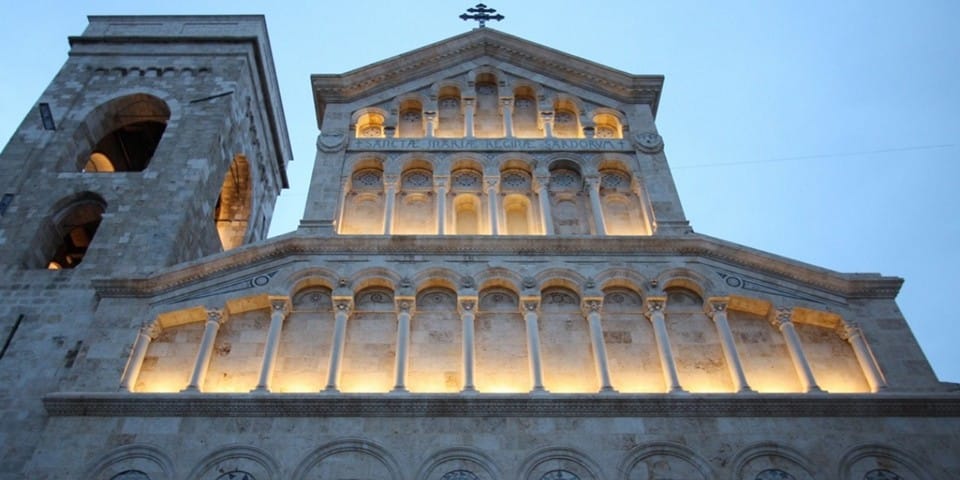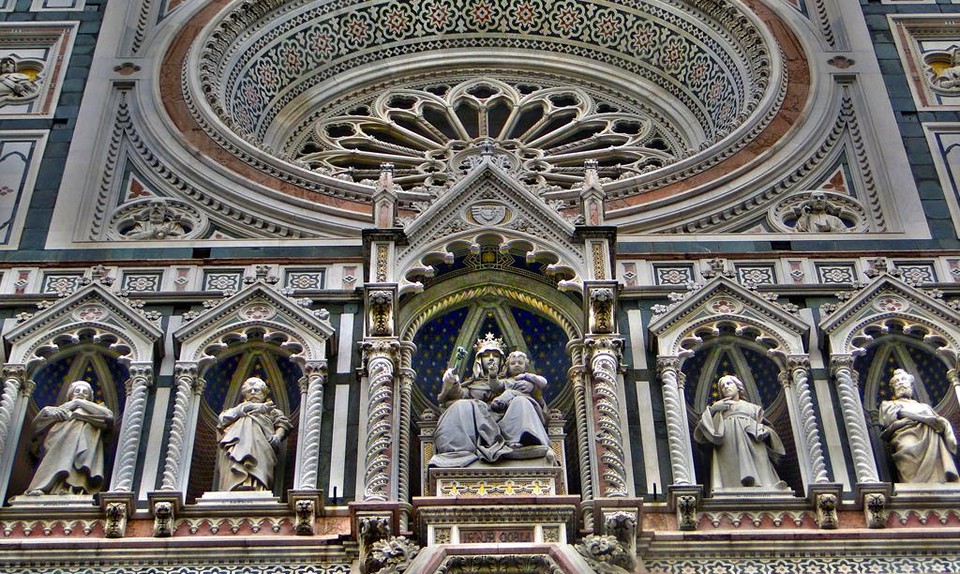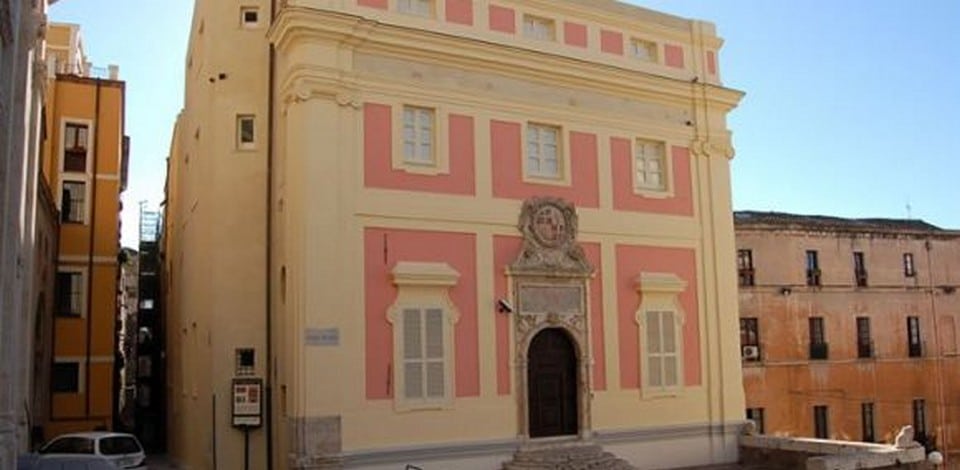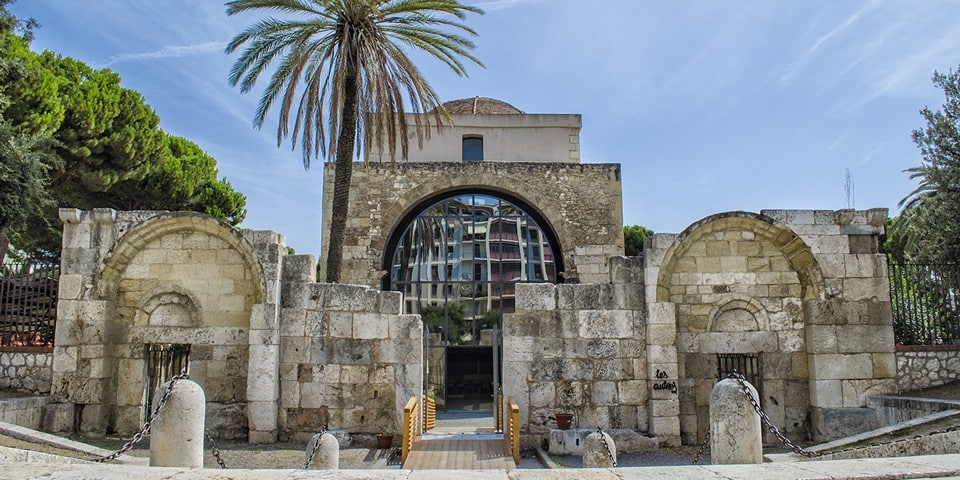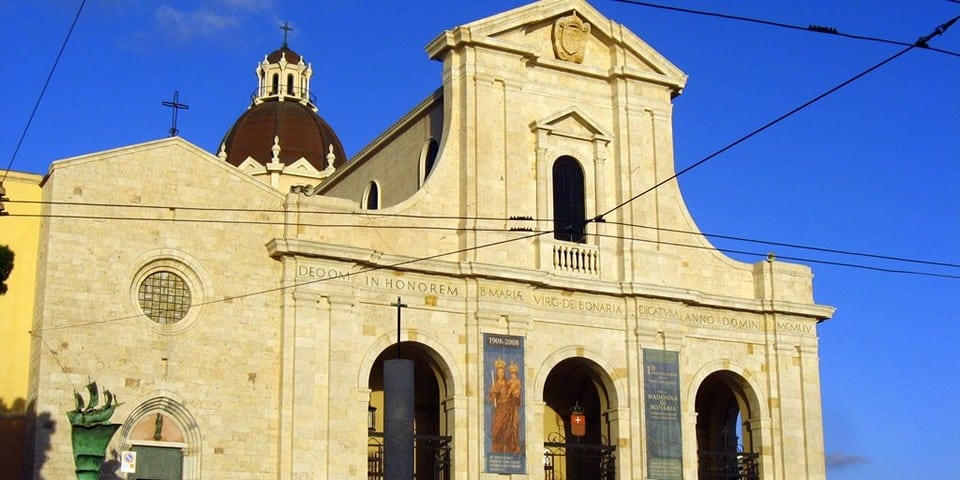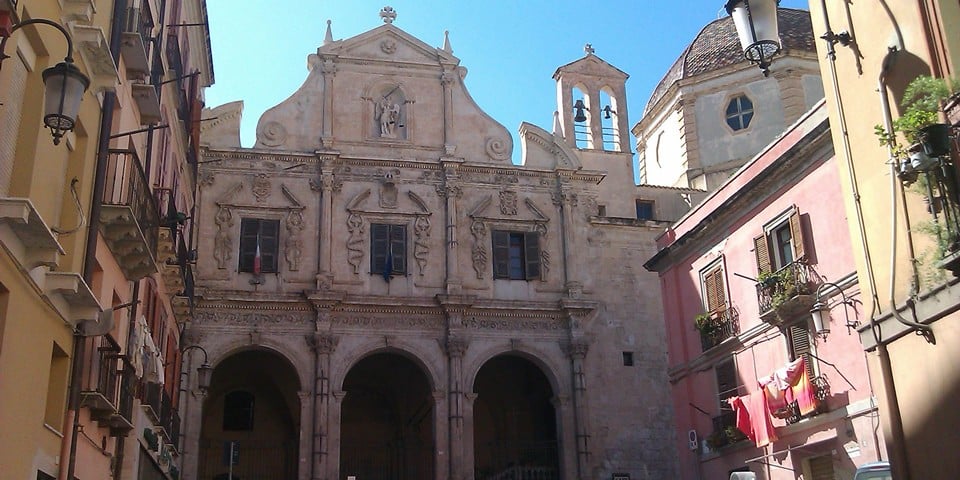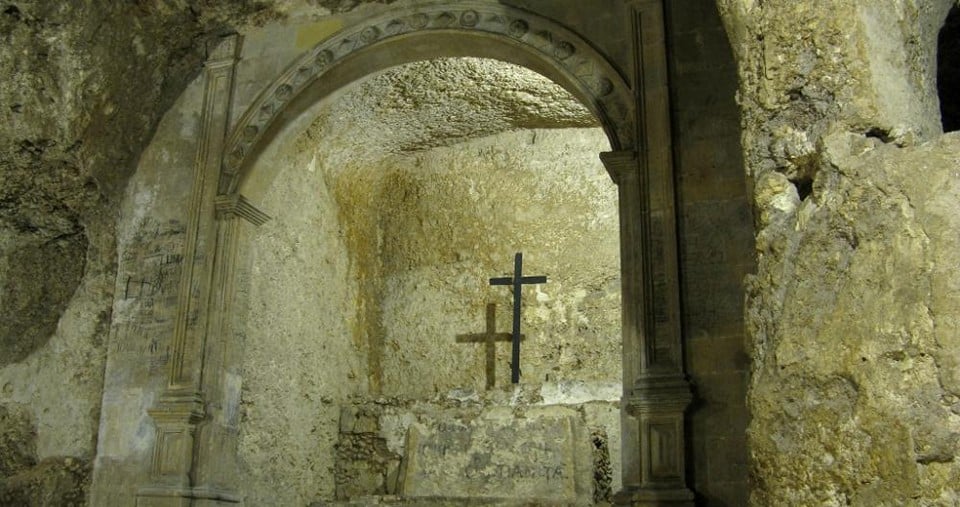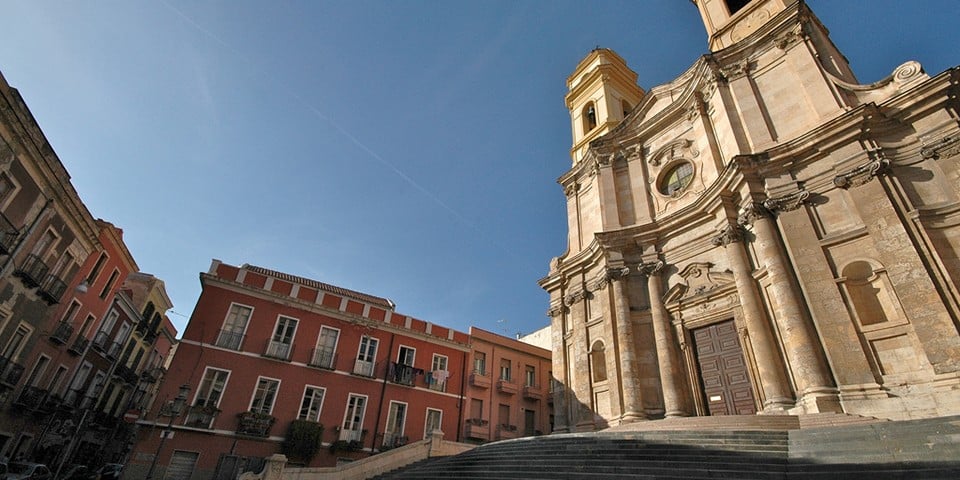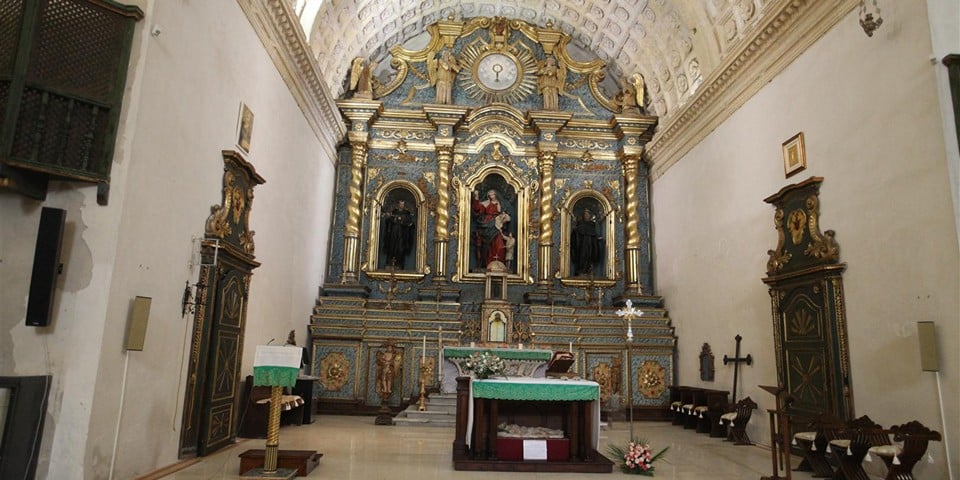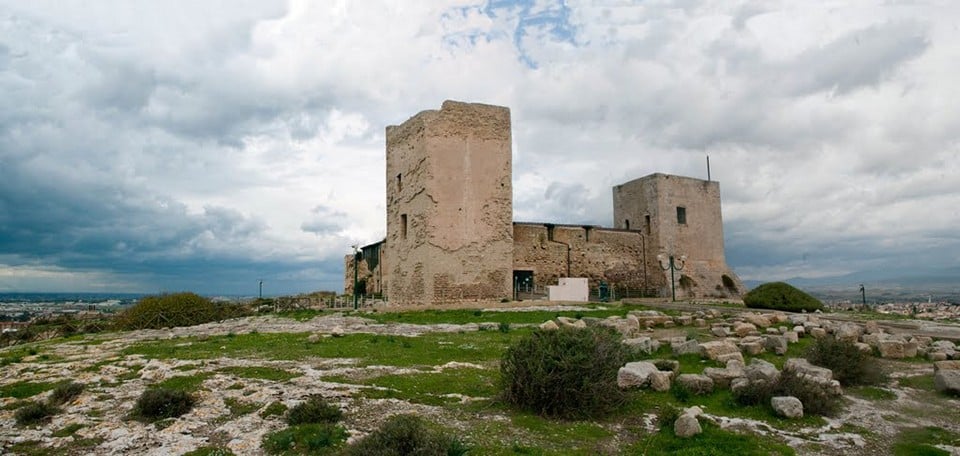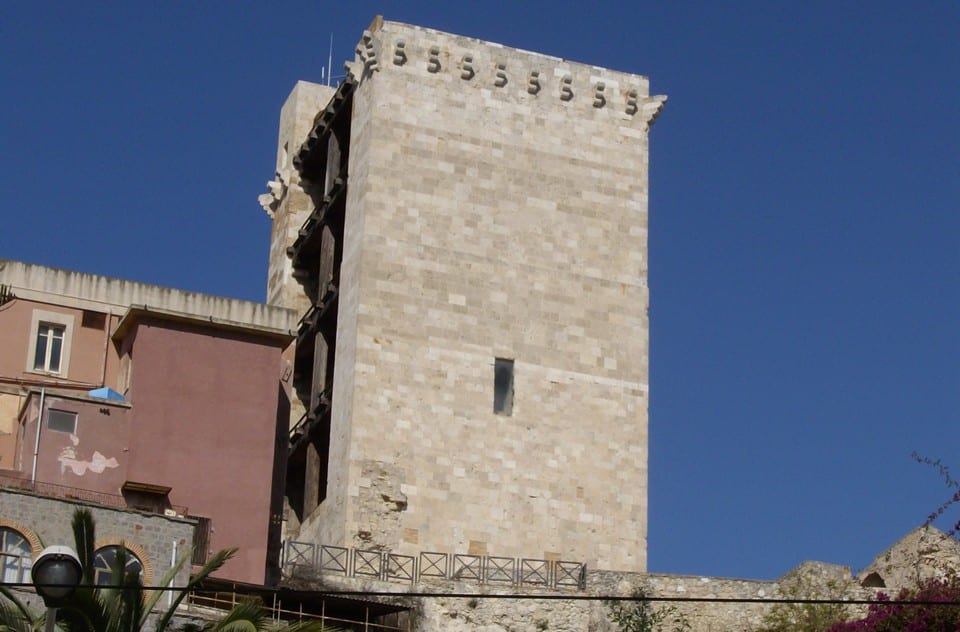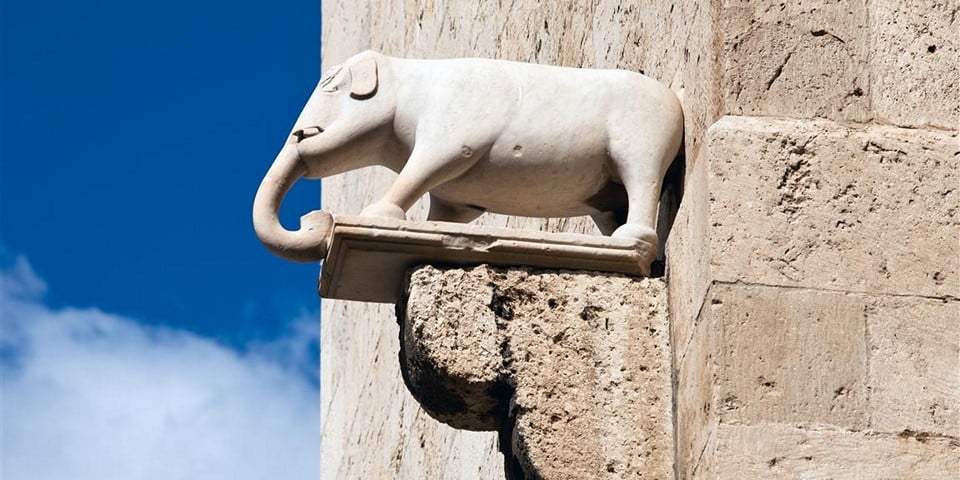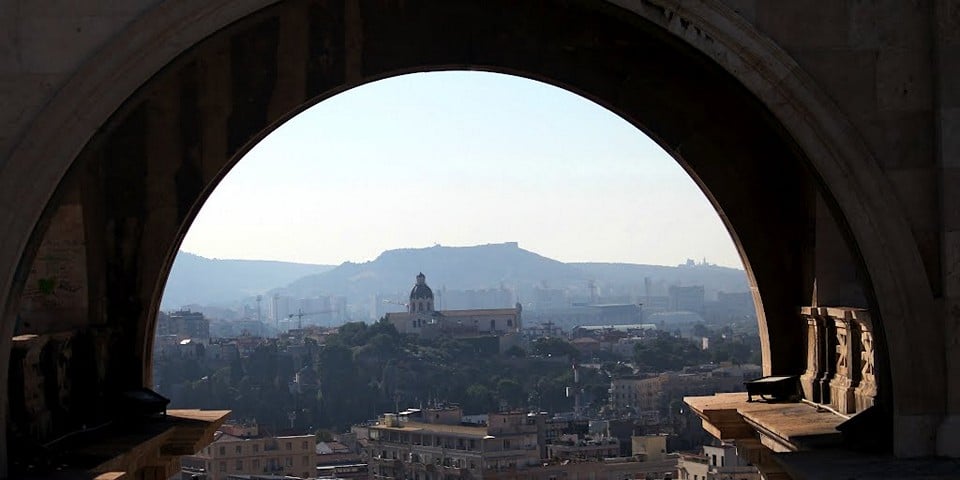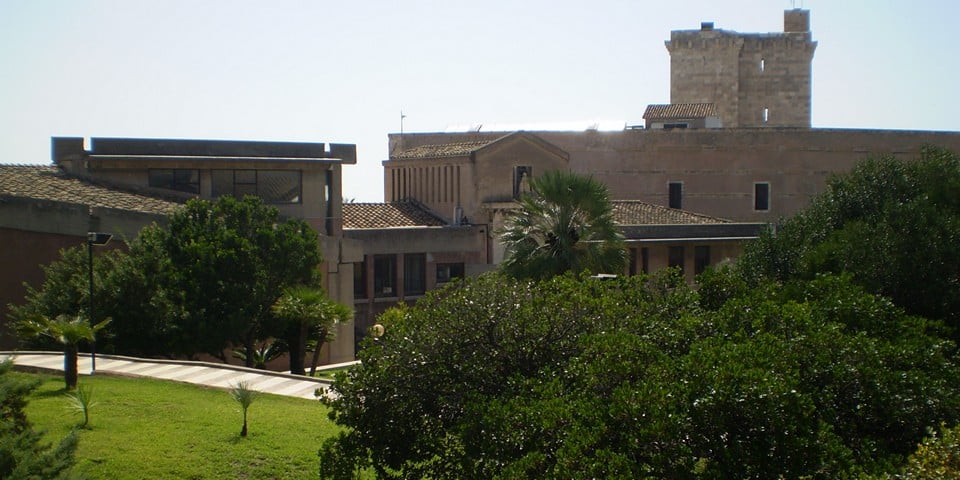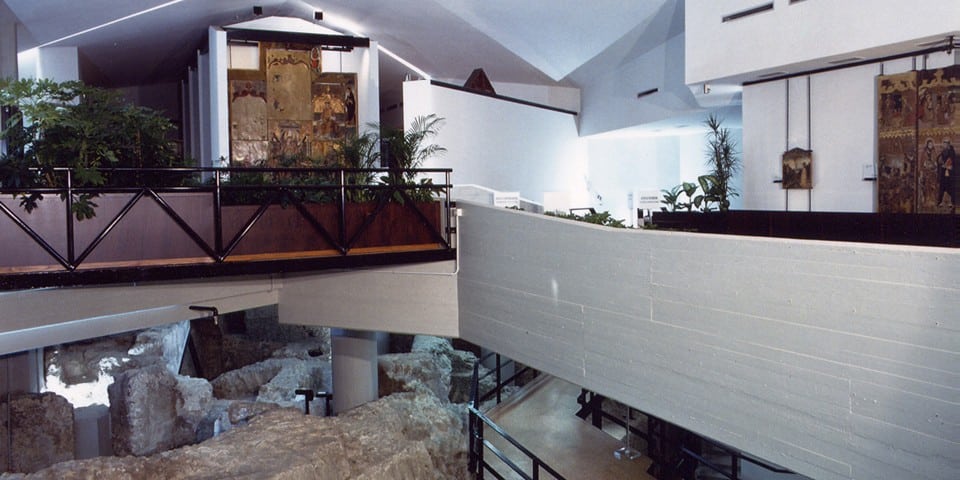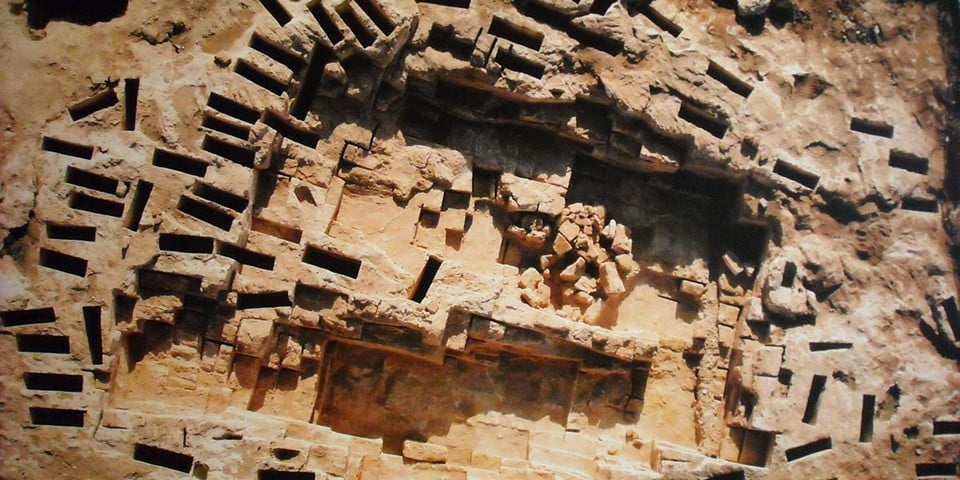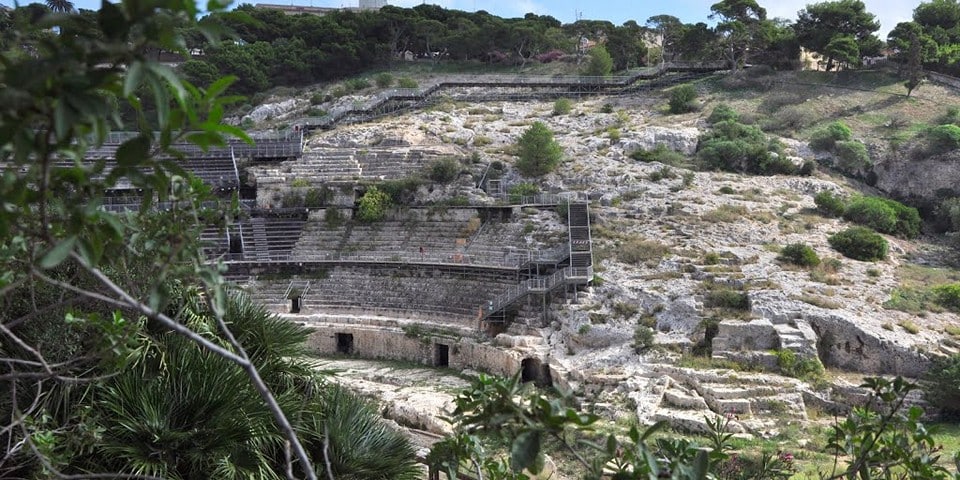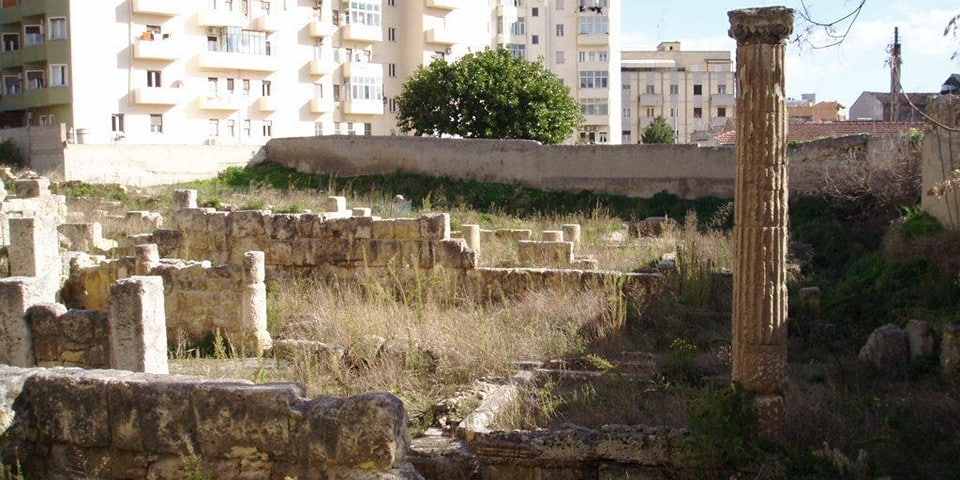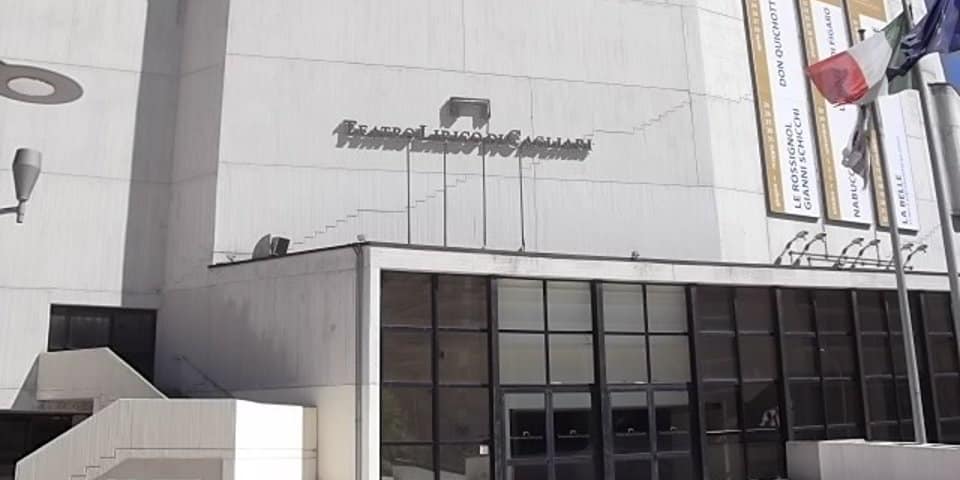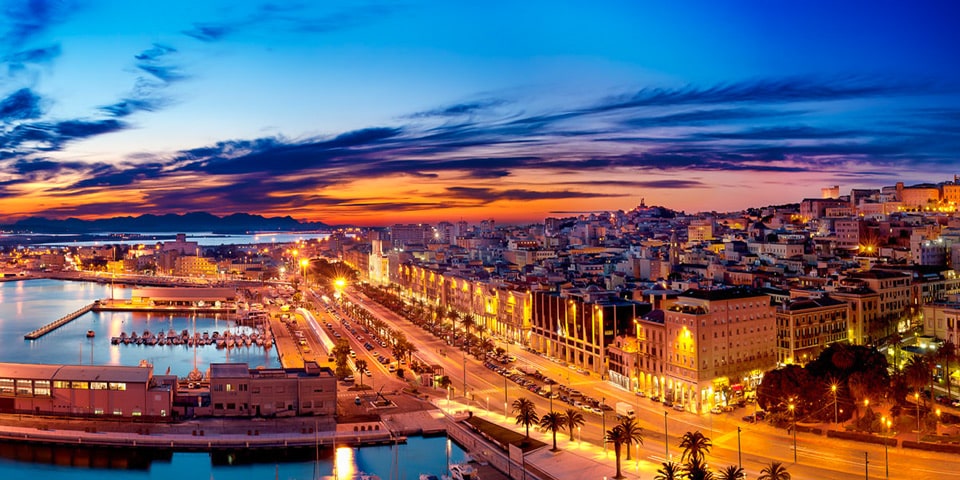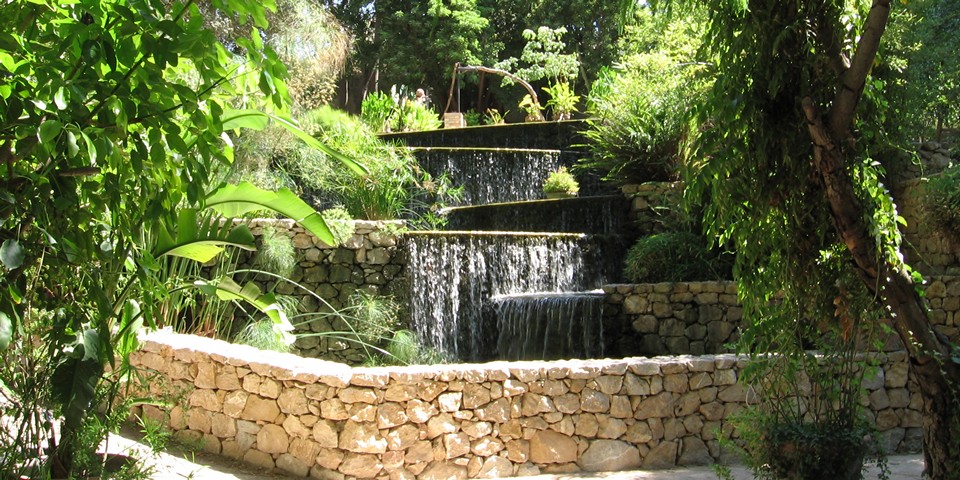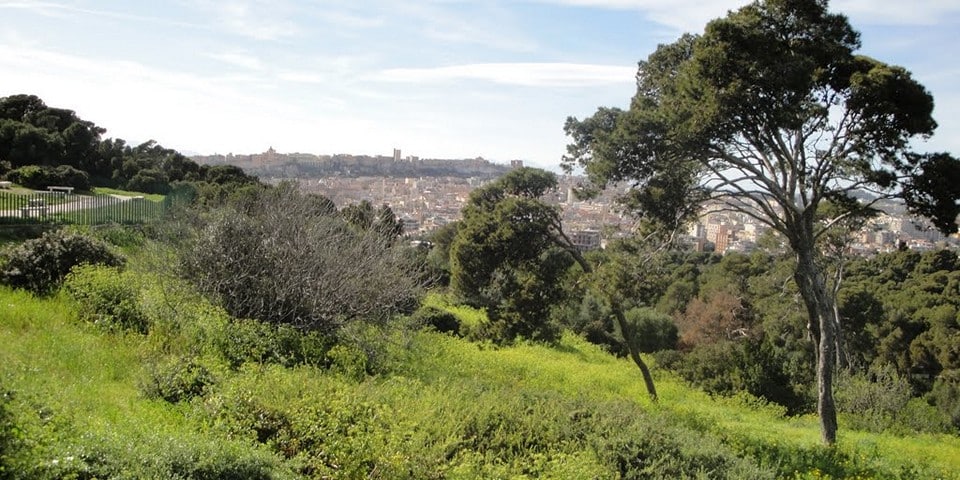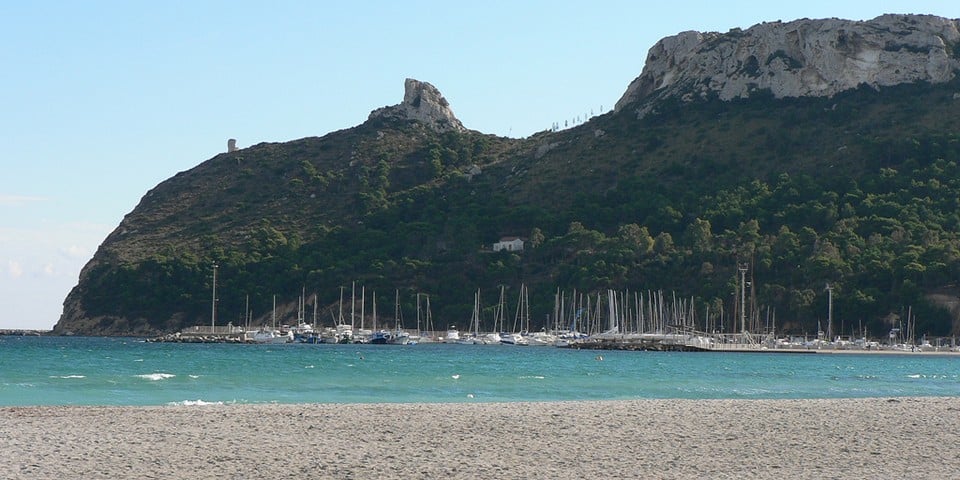Cagliari’s attractions are characterized by the bright sun, rugged cliffs, lush Mediterranean vegetation, and pristine beaches.
And, of course, the architecture, which harmoniously combines styles not only from different eras but also from different cultures. Because the city has been a convenient stopover on the busy maritime route from Europe to Africa for centuries, battles were constantly fought for the right to control it, and it changed hands frequently, which inevitably left its mark on its landmarks.
Page Contents
Palace Square in Cagliari
The main square of Cagliari is Piazza Palazzo (Palace Square). Here, you can find the Royal Palace (Palazzo Regio). In the past, representatives of the nobility built their houses around it, erected the town hall, the Cathedral, the Archbishop’s residence, and other essential city services.
Opposite the Cathedral, near the former town hall, a small square adjoins Palace Square – Piazza Carlo Alberto. In the past, executions, including beheadings of nobles, took place here.
Piazza Palazzo has undergone several renovations. The most significant changes occurred after World War II due to the severe damage many buildings suffered during bombings. As a result, some historic houses were demolished, and the square was expanded. Nevertheless, Piazza Palazzo managed to preserve its medieval character. To emphasize the antiquity of Palace Square, cars have been prohibited from entering recently; it is now a pedestrian zone.
Royal Palace
The Royal Palace (Palazzo Regio) was built in the first half of the 14th century by order of Peter IV of Aragon (Pietro IV d’Aragona), and for five centuries, it was home to kings. In the early 19th century, when Napoleon’s troops occupied Turin (Torino), it served as the residence of the Savoy ruling house (Casa Savoia).
In 1885, Palazzo Regio came under the control of the city, leading to a significant restoration of its interior rooms. The building was designated to house the prefecture (Prefettura) and the administration of the Cagliari province (Città metropolitana di Cagliari). The Council rooms were adorned with allegorical frescoes by the artist Domenico Bruschi.
Getting inside the palace can be a challenge; you need to arrange a tour in advance. Occasionally, concerts are held here, and in that case, you can explore the interior of the palace, where the kings once resided, after purchasing a ticket.
The Cathedral of Saint Mary in Cagliari
The Cathedral of Saint Mary (Cattedrale di Santa Maria) is the main temple in Cagliari. It houses important Christian relics – thorns from the crown of Jesus Christ and the remains of Sardinian martyrs. That’s why pilgrims from all sides gather here.
It became a landmark in the 13th century after the Pisans captured the city and destroyed Sardinia’s main temple dedicated to Saint Cyriacus. Accordingly, the city needed a new sanctuary, which became the church of the Santa Maria di Castello citadel. After some time, the church was granted cathedral status, retaining its name.
Following this, extensive renovations began in the cathedral, which were only completed in the 1930s. Therefore, the temple carries characteristics of different eras, and its main facade is designed in the Neo-Romanesque style. Inside the cathedral, elements of Baroque and Romanesque styles are present, with a predominance of silvery tones and the preservation of original frescoes.
Near the cathedral is the Martyrs’ Sanctuary. Here, there are three chapels. In one of them, the Chapel of St. Lucifer, there are eighty niches where the relics of saints are kept. Additionally, a monument to Maria Giuseppina Luisa di Savoia, who was buried inside the cathedral in 1810, is installed here. De facto, Maria Giuseppina was the Queen of France.
The Archbishop’s Palace
The Archbishop’s House (Palazzo Arcivescovile) is located between the cathedral and the Royal Palace, at Piazza Palazzo, 4. It was first mentioned in 1300, but there are strong grounds to believe that the building existed long before and served as a judge’s residence.
For a long time, it served as the residence of the archbishop, but more important people also lived here. For instance, during Napoleon’s time, the Sardinian King Carlo Felice resided here because the Royal Palace could not accommodate the entire court.
The current appearance of the Archbishop’s Palace owes much to the reconstruction carried out in the 1930s. On the side wall, one can see burial inscriptions dating back to early Christianity. Inside the palace, you can admire the original structure of the ancient cathedral’s facade, a marble staircase in the entrance hall, and a meeting hall renowned for its elegant decor and numerous paintings. Various archaeological findings are also stored here.
Cagliari Old Town Hall
The former Town Hall (Antico Palazzo di Città) is located at Piazza Palazzo, 6. The city hall was built in the 14th century and acquired its current appearance in the 18th century when its facade was designed in the Piedmontese Baroque style.
At the end of the 19th century, the city hall was relocated to a new building on via Roma, and the former Town Hall housed the music conservatory (Conservatorio di musica Giovanni Pierluigi da Palestrina). In the 1970s, the educational institution moved to via Bacaredda, and the building remained abandoned for a long time.
In 2009, the palace was opened to visitors, hosting exhibitions related to ethnography (Fondo Etnografico Manconi Passino), ceramics (Fondo Ceramico della Collezione Ingrao), and sacred art (Fondo d’Arte Sacra della Collezione Ingrao). In the basement of the building, you can see ancient cisterns used to collect rainwater, a medieval stone-paved floor, and archways decorated in the style of late Gothic.
Additionally, the Mayor’s office is located here.
Churches in Cagliari
In Cagliari, there are numerous ancient temples. Some of them are so old that they appeared long before the birth of Christ. For example, this applies to the crypt-cave where Saint Restituta, one of Sardinia’s first Christians, found her refuge in the 5th century. The city’s patron saint, Saint Saturninus, has a church not much younger; it definitely existed in the early 6th century. The other landmarks in Cagliari are equally fascinating, and their origins are associated with intriguing legends.
Basilica of Saint Saturninus
The Church of Saint Saturninus (Basilica di San Saturnino) is an ancient Christian church located at Piazza San Cosimo. Information about this landmark is first encountered in the writings of Deacon Ferrando, the biographer of Saint Fabius Fulgentius (Fulgenzio di Ruspe), who lived in the 6th century. He visited the church when he stayed at the nearby monastery.
The church is named after the city’s patron saint, Saint Saturninus (St. Saturninus of Cagliari), not by chance. The basilica was built near his burial site, where the martyr was beheaded in 304 AD for refusing to worship Jupiter.
In the 11th century, the church was transferred to the Benedictines, who restored it in the Romanesque style. In 1324, the monastery associated with the church was destroyed during military conflicts, leaving the church abandoned for a long time until services were resumed in the 18th century.
In 1943, the basilica suffered significant damage from bombings. After the war, it was restored and opened to parishioners. Nowadays, it is often used for wedding ceremonies. The church is open to visitors on Saturdays from 10 AM to 1 PM and from 3:30 PM to 7:30 PM.
Basilica of Our Lady of Bonaria
The Sanctuary of Our Lady (Santuario di Nostra Signora di Bonaria) is a complex consisting of a small 14th-century church and an adjoining large basilica, which holds the status of a minor papal basilica. This attraction is located at Piazza Bonaria.
The church’s origin dates back to the times of Sardinia’s conquest by King Alfonso of Aragon (Alfonso d’Aragona), who expelled the Pisans from here. In 1335, he assigned a small church and monastery to the Mercedarian monks.
In March 1370, a Spanish ship sailing the Mediterranean encountered a storm of such force that the sailors, in a bid to save themselves, decided to throw all the cargo overboard, including a heavy chest. As soon as it went overboard, the storm subsided. The chest washed ashore near Cagliari, not far from the church. Monks found it, and upon opening it, discovered a wooden sculpture of the Virgin Mary holding the infant Jesus in one hand and a lit candle in the other.
Since then, the Basilica of Our Lady of Bonaria has become a place of worship for pilgrims and sailors. A nearby church was built to house the sculpture, with construction starting in 1704 and concluding in 1926. It is the largest basilica on the island.
The Church of Archangel Michael
The Church of Archangel Michael (Chiesa di San Michele), located at Via Ospedale, 2, originally belonged to the Jesuits. Adjacent to it is a military hospital, which in earlier times served as the House of Jesuit Novitiate (ex Casa del noviziato).
Construction of the church began in 1674 and took forty years to complete. The church was consecrated in 1738, as evidenced by a memorial plaque on the right side of the portal. In the niche at the upper part of the facade, you can see a sculpture of St. Michael. He holds a sword (a symbol of faith) in one hand and scales (a symbol of justice) in the other.
The church is built in the Baroque style, and its interior is lavishly decorated in the Rococo manner. Inside, one cannot help but notice the ancient frescoes, sculptures, stucco work, and a beautiful mosaic dome. The church’s walls are covered in multicolored marble. Its eight chapels are connected by a long covered gallery that runs around the perimeter of the church. There is also a pulpit, from which Emperor Charles V Habsburg (Carlo d’Asburgo) addressed the people in 1535 before his campaign against the pirates. The pulpit was transferred here from the Church of St. Francis, which was demolished in the 19th century.
The Crypt of Saint Restituta
The cave crypt and the Church of Saint Restituta (Cripta e Chiesa di Santa Restituta) can be found on Via S. Efisio. Everything here exudes antiquity, as the cave was used for religious rituals even in pre-Christian times. The place has a gloomy and eerie atmosphere, accentuated by the echoing of water droplets falling from the vaults. In the 5th century, Saint Restituta sought refuge here, and she is considered one of the first Christian women in Sardinia. Her image can be seen on the walls of the crypt, which were decorated with frescoes in the 13th century. Altars dating back to the 5th century are also installed here.
The crypt was used as a church until the end of the 13th century, after which it was abandoned. In the 17th century, a church was built over it. Its establishment is linked to the rivalry for the title of Primate of Sardinia and Corsica (il titolo di primate di Sardegna e Corsica) between the archbishops of Cagliari and Sassari. During this competition, they organized excavations of ancient burials and places where early Christians held rituals. During these searches, the relics of Saint Restituta were discovered (although claims about the authenticity of the remains are still debated).
During World War II, the cave served as a shelter for citizens during air raids. Today, the crypt is open to tourists with free admission, while the church is closed for restoration.
Saint Anna’s Church
You can find the Collegiate Church of Saint Anna (La collegiata di Sant’Anna) on Via Domenico Alberto Azuni. This parish church is located in the Stampace district, situated in the upper part of the historical center.
The history of the basilica dates back to the 13th century when the citizens constructed a small church on the hill. Five centuries later, it was decided to demolish it and replace it with a more spacious building in the style of Piedmontese Baroque. The construction took a long time due to a lack of funds, and the right bell tower was only built in 1938.
As a result, the mention of the church’s construction became synonymous with something endless, never-ending, and when the citizens use the phrase “La costruzione di Sant’Anna,” they sarcastically refer to something that will never be finished, likening the discussed event to the long and troubled construction of the Stampace parish church.
As soon as the church was inaugurated, World War II began, and numerous bombings inflicted serious damage on the structure. Therefore, after the end of the hostilities, the church had to undergo restoration. The re-opening of the Church of Saint Anna took place in 1951.
Inside the church, many works of art are preserved. Among them, you can find a colorful altar in the Chapel of the Sacred Heart of Jesus, a neoclassical black altar dedicated to Duke Amadeus IX of Savoy (Amedeo IX di Savoia il Beato). You can also see wooden sculptures of Saints James and Anna (santi Anna e Gioacchino) holding Jesus, and a painting by Giovanni Marghinotti depicting the Redeemer among angels.
Saint Augustine’s Church
Saint Augustine’s Church (Chiesa di Sant’Agostino) is located on Via Lodovico Baylle, 80. The basilica’s facade is unremarkable, which might cause tourists to pass by it without recognizing it as a place of worship. Nevertheless, Saint Augustine’s Church is the city’s only example of Renaissance architecture.
The church was built in the 16th century and was originally conceived as a hermitage, explaining the simple appearance of the facade facing the east. There is also a more interesting entrance from Largo Carlo Felice, leading to the uniquely decorated courtyard of the church. Inside the church, you will find many frescoes and a ceiling adorned with rosettes. The partially plastered walls enhance the sense of antiquity. There is also a Baroque-style altar and several statues of saints.
Recently, traces of ancient Roman structures were discovered around the church. Therefore, ongoing archaeological work is conducted in its vicinity, occasionally leading to the closure of the church for visitors.
Defensive Structures in Cagliari
Since Sardinia was frequently attacked, defensive structures, including formidable fortresses, bastions, towers, and walls, were erected to protect Cagliari in the early 14th century. These defenses shielded against enemy attacks and served as observation points. The towers provided excellent views of both the sea and the land.
Only after the island became part of the unified Italy in 1861 did the city lose its status as a “defensive fortress.” Consequently, the decision was made to demolish parts of the walls. Those sections that didn’t hinder the development of urban architecture were preserved.
Saint Michael’s Fortress
Saint Michael’s Fortress (Castello di San Michele) is situated on a hill, with its slopes extending into the park of the same name. This attraction is located four kilometers from the city center on Via Sirai.
On the sides of the medieval castle, you can see three towers. A moat is dug from the outside in front of its walls. It is the oldest fortress in Cagliari that has survived to this day, as it was constructed in the 10th century. Initially, the castle was used solely as a defensive structure. Then, from 1350 to 1511, the fortress became the residence of the noble Carroz family. During this time, the park was established.
In the 17th century, the city was hit by a plague, leading to the decision to use the fortress, which had been abandoned for a long time by then, as a hospital. In other words, it was used to isolate the sick. After the epidemic, the castle was fortified to defend against the French in the 17th and 18th centuries. In 1940, it served as a base for the naval fleet.
Today, the building is well-preserved and open to tourists. Temporary exhibitions and theatrical performances are held here. From the hill, you can enjoy a view of the surrounding area.
San Pancras Tower
San Pancras Tower (Torri di San Pancrazio) is located on Piazza dell’Indipendenza, at the highest point of the Castello district. The Pisans built this landmark in 1305 to protect Cagliari from Saracen pirates and Genoese forces. Three of its walls are solid, designed to defend the city, with narrow, small openings. The fourth side facing Castello features balconies on four levels. At the base of the structure, there are gates bearing the same name, which in earlier times provided access to Castello.
San Pancras is the tallest tower in Cagliari, currently standing at a height of 36 meters, with wall thickness of 3 meters. In the past, it was significantly taller, but bombardments by attacking English (1701) and Spanish (1717) forces partially destroyed it. In 1793, during the siege of Cagliari by Napoleon’s troops, San Pancras lost its peak.
When the Aragonese dynasty began ruling the city, San Pancras was turned into a prison. In 1906, the structure was restored. Today, the tower is open to tourists, and from its observation platform, you can enjoy a magnificent view of Cagliari and its surroundings.
The Elephant Tower
The Elephant Tower (Torre dell’Elefante) is located at Piazza S. Giuseppe. It’s the second-largest tower in Cagliari, standing at a height of approximately 101.7 feet (31 meters). This landmark was constructed in 1307 and was named after one of the symbols of Pisa – an elephant, the sculpture of which was placed approximately 32.8 feet (10 meters) above the ground.
Many refer to Torre dell’Elefante as the twin of San Pancrazio. It also features four levels, three solid walls, and one with balconies. At the bottom, there’s a portal that served as an entrance to Castello. It shares a similar fate as well; at one point in time, it also housed a prison. Not far from the tower at Piazza Carlo Alberto, there was a place of execution, and the severed heads of individuals were displayed on its walls. Some of them remained there for several years. Hence, locals believe that on windy nights from the square where people meet their end, the voices of their souls can be heard.
Currently, access to the tower is open to tourists. Climbing to the top can be challenging, but the view of the city streets and the bay is enchanting.
San Remy Bastion
San Remy Bastion (Bastione di San Remy) is situated at Piazza Costituzione. It was built at the end of the 19th century to replace the dismantled fortress walls that connected Castello to other districts of Cagliari. The bastion got its name from Baron San Remy, the governor of Piedmont (Piemonte), by whose order this landmark existed.
Bastione di San Remy is an impressive structure with high arched windows on its sides. A double staircase leads up and ends near the Triumphal Arch, which you can pass through to reach the Umberto I terrace (Umberto I) with benches and palm trees. From here, you can enjoy a magnificent view of the surroundings. From the rear, the bastion appears absolutely impregnable, with powerful walls rising above sheer cliffs.
Inside the structure, there’s a covered passage. Initially, it housed a banquet hall, and during the First World War, it served as a medical station. In the 1940s, people whose homes were destroyed by the war lived here. Nowadays, the covered passage has been restored, and art exhibitions are held here.
Cagliari Museum Citadel
Several museums in Cagliari are housed within the former Citadel, which is why the museum complex is called La Cittadella dei Musei. The fortress is located at the highest point of the Castello district, with the entrance from Piazza Arsenale, 1.
The Citadel appeared in the 18th century on the site of dismantled defensive structures. Until 1825, it housed an arsenal. During World War II, the building was often targeted by air raids and bombings. Restoration of the fortress began in 1965 and lasted for fourteen years.
Today, the former fortress houses exhibitions:
- Archaeological Museum.
- Anatomical Museum of Wax Figures “Susini.”
- National Art Gallery.
- Stefano Cardu Museum of Siamese Art.
Additionally, spaces within the Citadel are used for temporary exhibitions, conferences, and a restaurant. Since the fortress is located on a hill, visitors to the old fortress are treated to a magnificent panorama.
Archaeological Museum
The National Archaeological Museum (Museo Archeologico Nazionale di Cagliari) is located at Piazza Arsenale, 1. It houses unique exhibits, including bronze figurines and other artifacts dating back to the Nuragic era. It gets its name from the type of towers that were widespread on the island from the second half of the 2nd millennium BC to the 8th century AD.
The museum’s history began in 1800 when Vice-King Carlo Felice organized a cabinet of archaeology and natural history in the halls of the Viceregio Palace. Two years later, the museum’s exhibits were opened to the public. In 1806, the exhibition was given to the university, after which it moved to Palazzo Belgrano.
The museum arrived at the Arsenal Square in 1993. Its exhibits are spread over three floors, allowing visitors to explore the history of Sardinia from the Neolithic period to late antiquity in chronological order. Among the exhibits are ceramic objects, a Phoenician necklace made of faience, and Punic and Roman coins.
Anatomical Museum of Wax Figures “Susini”
The Anatomical Museum of Wax Figures dedicated to Clemente Susini (Museo delle cere anatomiche intitolato a Clemente Susini) houses one of the most interesting collections in the world. It features wax sculptures representing various parts of the human body (head, muscles, throat, liver, etc.), providing a detailed representation of different organs.
The collection was established between 1801 and 1805 through the initiative of Professor Francesco Boi. The wax sculptures were crafted in Florence by artist Clemente Susini. The models created by him arrived in Cagliari in 1805 and were housed in the museum of the Royal Palace for about half a century. The exhibits were later transferred to the university and subsequently relocated multiple times until they found their home in the Citadel.
National Art Gallery
The National Art Gallery (Pinacoteca nazionale) emerged in the second half of the 19th century when many church treasures became state property. The museum is located on three floors in chronological order, with the oldest exhibits on the top floor.
The National Art Gallery features works by Sardinian artists from the 16th to the 18th centuries. Among them is Pietro Cavaro, a local artist and one of the most renowned painters in Sardinia. The collection also includes Sardinian and Catalan altarpieces from the 15th and 16th centuries. The ethnographic collection is particularly noteworthy, showcasing Sardinian textiles, furniture, ceramics, and weaponry.
Museum of Siamese Art
The Museum of Siamese Art (Museo civico d’arte siamese Stefano Cardu) was established after Stefano Cardu donated his collection to the city in 1914, acquired during his travels in Indochina. Initially, the exhibits were displayed in the Municipal Palace (palazzo Civico), and later in the art gallery. Since 1981, the exhibition has been housed in the Citadel.
The Siamese collection consists of paintings depicting various stories from the Ramakien, manuscripts, Buddhist sculptures made of ivory, wood, and silver. There is also an extensive collection of porcelain, various figurines (okimono, netsuke), and a remarkable collection of Eastern coins and weapons.
Archaeological Excavations in Cagliari
Cagliari is a very ancient city. Numerous excavations bear witness to the fact that this settlement existed as far back as the 18th century BCE. Primarily, this is evidenced by the world’s largest necropolis, which emerged here during the Neolithic era. Additionally, within the city’s territory, archaeologists have discovered the ruins of residential houses dating back to the 1st century BCE. The massive amphitheater attests to the vibrant life during the time of the Roman Empire.
Punic Necropolis
The Punic Necropolis (Necropoli Punica di Tuvixeddu) is situated on the hill known as Colle Di Tuvixeddu, which translates from Sardinian as the “hill of small holes.” Its name is not coincidental: it features numerous burial recesses, some adorned with well-preserved reliefs.
In total, archaeologists have unearthed over a thousand tombs on the necropolis grounds, dating back to the Carthaginian and ancient Roman periods.
The first burials appeared here during the Neolithic era, as evidenced by discovered flint tools and ceramic artifacts (3800-2900 BCE).
The most intriguing tomb is the Serpent’s Grotto. Its exterior is decorated with a façade depicting two serpents. Inside, two burial chambers bear inscriptions recounting the individuals laid to rest here. According to these inscriptions, a married couple, Atilia and Cassius Philippus, are buried here. When the husband fell seriously ill, his wife implored the gods to allow her to die in place of her spouse, and they granted her request. The woman was interred on this hill. Subsequently, when Cassius passed away, his remains were laid to rest beside Atilia.
Roman Amphitheater in Cagliari
The Roman Amphitheater (Anfiteatro romano) is located on Via Sant’Ignazio da Laconi. This landmark harmoniously integrates with the surrounding cliffs. From above, the structure is enveloped by a city street, offering different perspectives for viewing.
Anfiteatro romano came into existence in the 1st-2nd centuries CE when Sardinia was under the rule of the Roman Empire. Half of the structure was carved into limestone rock, while local limestone blocks were used for constructing the southern portion. The amphitheater could accommodate 10,000 spectators, and its arena hosted battles between animals, gladiators, and specially recruited combatants. Here, in front of cheering crowds, executions were carried out.
Due to the spread of Christianity, gladiatorial contests became unpopular, and in 437 CE, they were banned altogether. Afterward, the amphitheater in Cagliari remained in neglect for a long time, with local residents and rulers utilizing its stones for new constructions.
The deterioration of this landmark persisted until the mid-19th century when Anfiteatro romano came under the city’s protection and authority. Since then, various performances have been held here, involving the covering of parts of the amphitheater with iron and wood. Such actions drew criticism from archaeologists who argued that such constructions harm the landmark. Currently, the authorities have reconsidered their stance, and there are plans for a restoration aimed at restoring the amphitheater to its original appearance in the near future.
Villa Tigellio
Villa Tigellio (Villa di Tigellio) is located on Via Tigellio, 18, not far from the botanical garden and the Roman amphitheater. This place is not a villa in the direct sense of the word; it houses the ruins of buildings dating back to the 1st century BCE. Previously, scholars believed that it was the villa of the famous Sardinian musician Tigellio. However, it was later discovered that he had no connection to these structures, but the name stuck.
Archaeological research confirmed that three main buildings were located here, which were inhabited until the fourth century. In one of them, scientists found a mosaic floor, frescoes, and in another – gypsum decorations, several vertical columns, and rainwater collection points.
The Theaters in Cagliari
Cagliari boasts numerous theaters, each with its own history and a special place in the city’s life. Almost all of them emerged after World War II as theaters that existed before the war were destroyed by bombings. Currently, the main ones are the two temples of Melpomene – the Massimo Theater and the Lyric Theater.
The Massimo Theater
The Massimo Theater (Teatro Massimo) is located on Via Edmondo De Magistris. It was built inside Mr. Merello’s old steam mill, who, along with another entrepreneur, Ivo Mazzei, decided to build a theater here.
Construction was completed in 1947, resulting in one of Italy’s largest theaters, with a capacity of 2,500 and an area of 4,500 square meters. It hosted not only theatrical performances but also movies. In the 1970s, the theater’s owners decided to demolish it to make way for several buildings. In 1981, Teatro Massimo was reopened and operated until a serious fire occurred, leading to its closure.
In 2004, one of the heirs of the theater’s founder, John Merello, terminated the contract with the Mazzei family’s heir and began restoring the building. This involved the removal of the external facade, balcony, and some other elements.
The new theater was inaugurated in 2009. It has two halls, one with 752 seats and the other with 202 seats. Since then, many opera singers and important theatrical figures have performed within its walls.
The Lyric Theater
The Lyric Opera House (Teatro Lirico) is located on Via Sant’Alenixedda. Construction began in 1971 and was completed in 1993. The purpose of its construction was to overshadow the Civic Theatre, which was destroyed by a fire in 1942.
Currently, Teatro Lirico is a modern building with a capacity of 1,650 seats. In addition to the main stage, it features rehearsal rooms, a bar, a restaurant, offices, and a bookstore. The Red Room is designed for conferences and educational events. An adjacent library complements the main building.
Where to Relax in Cagliari
Cagliari is a very green city. Another advantage is that many parks are located very close to the city center. Strolling along the shaded alleys, you can admire the lush Mediterranean vegetation and observe various birds’ life. If desired, you can go to the beach. Here, you’ll find one of Italy’s longest beaches.
You may also find articles about:
Botanical Garden
The entrance to the Botanical Garden (Orto Botanico) is located at Via Sant’Ignazio da Laconi, 1, about one kilometer from the Cathedral. It was opened in 1864, and within a decade, it housed more than 193 plant species. During World War II, the garden was demolished because it was used as a cavalry post. Therefore, after the war, considerable effort was needed to restore the Botanical Garden.
Now, Orto Botanico covers 5 hectares, hosting thousands of plants, including very rare specimens. Mediterranean flora grows in the open air, and greenhouses have been created for some plants brought from South America and Australia. History enthusiasts can view ancient Roman cisterns located here.
Admission to the Botanical Garden is chargeable.
Monte Urpinu
Monte Urpinu Park (Parco di Monte Urpinu) is situated on the hill of the same name, not far from the center of Cagliari. The main entrance is on Viale Europa.
Parco di Monte Urpinu is considered one of the most beautiful parks in Cagliari. It boasts numerous trees and flowers. The park features a lake inhabited by sea turtles, flamingos, swans, and peacocks. From the hilltop, you can enjoy a magnificent view of the city, the bay, and the Molentargius Park ponds. There are tennis courts, football fields, and children’s playgrounds for sports enthusiasts.
Cagliari Molentargius Park
The Molentargius Regional Park (Parco Naturale Molentargius-Saline) is a nature reserve inhabited by many waterfowl, animals, and reptiles. Among them are storks, herons, flamingos, cormorants, turtles, and nutrias.
The main entrance to the park is located on Via la Palma, covering an area of over 1,600 hectares. There are numerous ponds, paths, and alleys here. Both pedestrian and bicycle tracks have been laid out. You can also explore the park by choosing a water route.
Poetto Beach
The Poetto Beach (Spiaggia di Poetto) stretches for more than seven kilometers. There are both paid and free sections. In summer, the beach is very crowded, especially in its southern part. So, if you want to relax without the crowds, it’s better to come here in the second half of September when the sea is still warm, and many people’s vacations have ended.
The infrastructure here is well-developed, including bars, restaurants, discos, and a yacht club. You can rent sun loungers (including those for the disabled), umbrellas, and other beach accessories. In the latter part of summer, an open-air cinema operates. Prices are significantly higher here on weekends or when the beach is crowded.
 Italy for me From Italy with love
Italy for me From Italy with love

